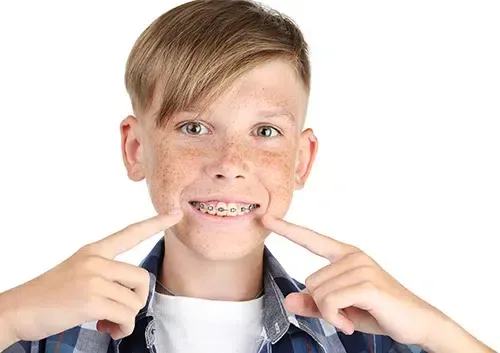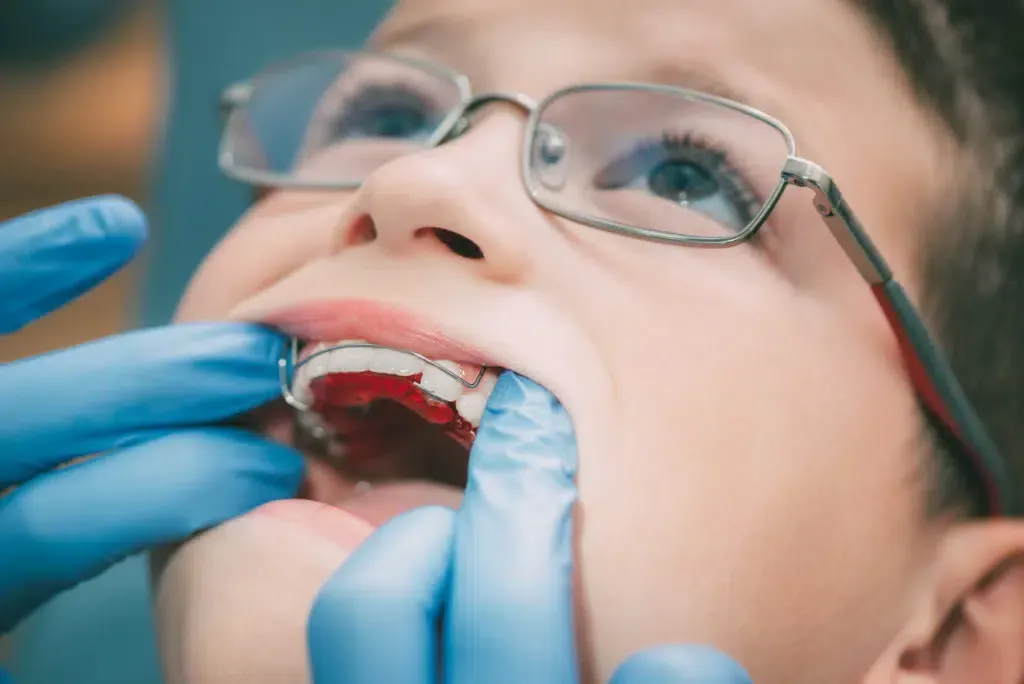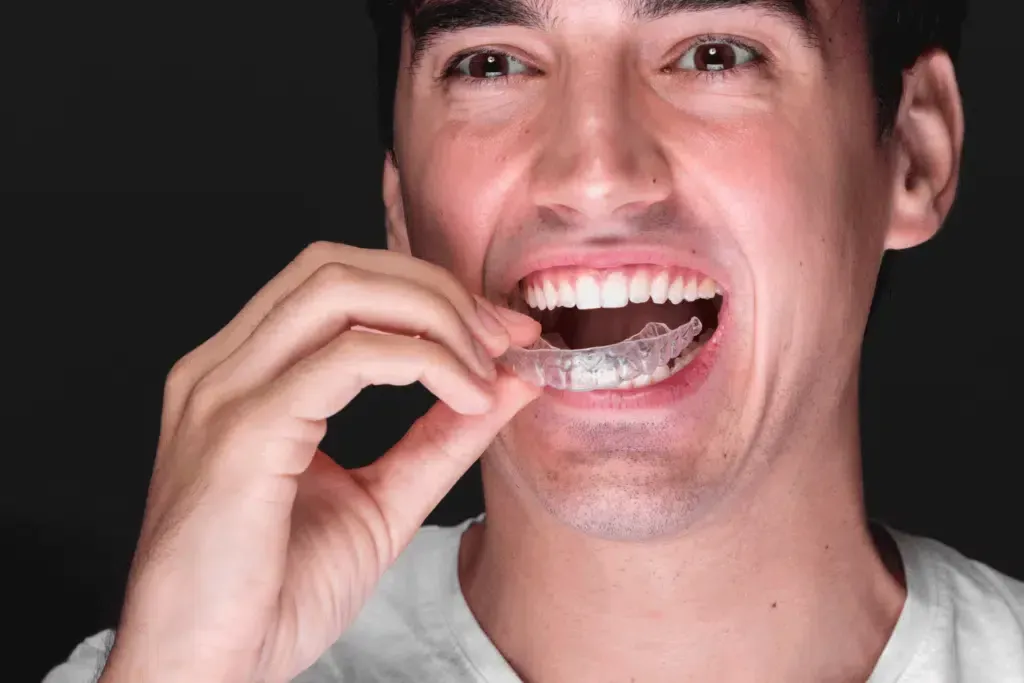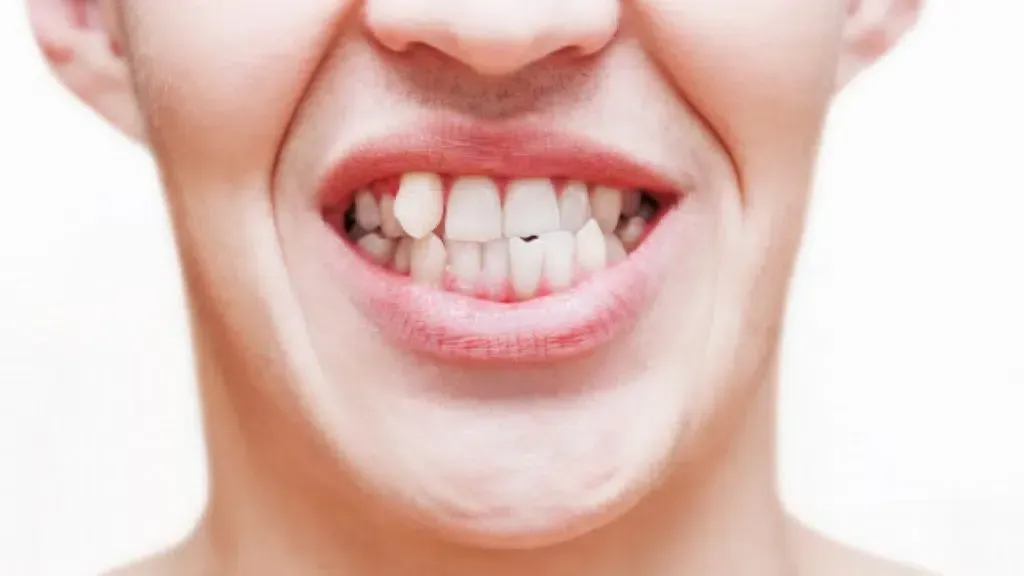Our Blog

How important is your smile to you? According to the Academy of General Dentistry, 96% of people believe that a smile is important to a person’s appearance. For a lot of us, a beautiful smile means having straight, aligned teeth. Unfortunately, most of us don’t naturally have straight smiles, which means braces or Invisalign aligners are usually great options to consider when trying to get a smile you love. But how do you know which option is best for you or your child? Both Invisalign and braces will straighten your teeth, but offer different unique benefits that suit the needs of different patients. We have outlined below everything you need to know about both options to help you make your decision on whether Invisalign or traditional braces are better for you or your child. Appearance We’re all familiar with the appearance of traditional braces. We have come a long way from chunky train-track style braces of the past as braces continue to be designed smaller and smaller. Clear braces are also an option now. They have the same pieces as traditional braces except they are made of clear ceramic. Invisalign is also popular option due to the invisibility. Many patients prefer the inconspicuous look of Invisalign aligners. Adult and teenage patients in particular love that their peers can’t see that they are undergoing orthodontic treatment. Functionality Braces are worn 24/7 as you are not able to take braces off. Thus, you must avoid hard and sticky foods so that the braces do not get damaged or come loose. With Invisalign the aligners must be removed when eating and drinking anything besides water. This means you don’t have to change your diet or the way you eat certain foods. Oral Hygiene Invisalign must be removed when you brush your teeth, meaning you will not have to alter your oral hygiene routine too much. You can continue to brush and floss as you have always done. However, you will also have to brush and clean your Invisalign aligners. With braces, specialized tools such as water flossers and floss threaders are helpful to remove all food and plaque from the braces. Comfort Straightening your teeth can cause slight discomfort as the teeth are being moved in the surrounding jaw bones. Braces will take a few days to get used to and for the inside of your cheeks and lips to become accustom the the braces. Invisalign will also take some getting used to. Both treatment options will cause some soreness temporarily. Ibuprofen, Tylenol, or Motrin can be taken to help alleviate the discomfort. Effectiveness Both methods are very effective treatments. Braces cannot be removed by patients and therefore are highly effective. Invisalign requires discipline from patients to ensure you wear the aligners for the recommended amount of time to ensure you get the desired effect as quickly as possible. The Verdict In short, it ultimately comes down to personal choice. Invisalign is a great option for those of us who want a discreet, efficient and comfortable solution to straightening teeth. However, some people prefer braces due to the fact that you don’t have to remember to put your braces on as they are fixed in place. If you’ve been considering straightening your smile, give us a call today to schedule a consultation to see which option would be best for you.

You’re going to the game! And no matter which sport you follow, there’s so much to enjoy—the best athletes, exciting play, hometown pride—and those delicious concession stands! But if you’re wearing braces, your team spirit might be flagging. Here are a few ideas to help keep your food choices out of foul territory. You know that you should avoid the foods that can damage braces or stick around your wires and brackets. This means any snacks that are sticky, chewy, hard, or crunchy are benched. So most of the traditional game foods—peanuts, popcorn, licorice—are just not safe for traditional metal or ceramic braces. Let’s save those for next season. So what is on the program? You still have many great choices. Ice Cream – A favorite that’s easy on your braces. Dip and Dots are also a great choice! If you want a healthier option, try frozen yogurt or a smoothie. Hearty Snacks – Pretzels, pizza, hot dogs, and hamburgers are all perfectly fine to eat with braces. Remember to take smaller bites! Soft Candies and Cookies. Licorice, caramels, and crunchy cookies are out, but soft chocolate bars, soft cookies, and cotton candy are still on the menu. Just remember to get a good brush and floss in when you get home. Sodas and sports drinks can create a sugary and/or acidic environment which can damage enamel over time. If you do indulge, try to rinse with water ASAP and brush and floss when you get home.Stadium and arena menus contain a lot of starches and sugars, which stick to braces and fuel cavity-causing bacteria. So it’s best to go easy on the snacks. But you don’t have to give up a half-time treat entirely—just enjoy in moderation and be sure to brush thoroughly when you get home. If you wear clear aligners, your choices are simpler. You can remove your aligners, eat normally, and clean your teeth thoroughly before replacing them. But one flag on this play—remember that you’re supposed to wear your aligners for a set number of hours each day. You don’t want to be putting your treatment behind schedule if the game goes into triple overtime. Keep your eye on the clock, and you should be fine. Dr. Ashlee Weber and our team are always happy to recommend the best food options for your individual orthodontic treatment, and we can help you select a roster of safe and healthy choices. You might miss out on a few of your favorite sports snacks right now, but let’s remember the true fan’s motto: There’s always next year! Taking care of your braces and teeth means faster treatment and healthier teeth. Your All-Star smile will be worth it!

It is broadly understood that the primary purpose of orthodontic treatment is to improve the alignment of the teeth and provide you with a beautiful, confident smile. However, the benefits of orthodontic treatment do not just stop there! Read below to learn about the top 10 benefits of orthodontic treatment: Smile Esthetics: This may be one of the most obvious benefits of orthodontic treatment. An orthodontist can help you not just straighten your teeth, but also get an attractive, confident smile. At Weber Orthodontics we strive to give every one of our patients a customized, attractive smile that flows with their facial appearance and looks naturally attractive. Facial Esthetics: Besides straightening the teeth, orthodontic treatment may improve the relationship between the upper and lower jaws so the teeth can come together properly. This dental and jaw harmony can have a positive impact on your face shape, profile, and features. This is especially evident in the more severe cases, such as with an underbite or overbite. With her thorough diagnosis and precise treatment plans, Dr. Weber is an expert in balancing function and aesthetics. Oral Health: Crooked and crowded teeth may be more difficult to clean and maintain, causing a higher risk for cavities and periodontal disease. Orthodontic treatment can help minimize those risks by aligning the teeth and placing them in their ideal, easy to clean positions. Risk of injury to teeth: In some cases, the mal-positioned teeth may be at a higher risk of injury or trauma. For example, if your child’s teeth stick out too far, they are at a higher risk of fracturing if the child falls or hits their face. Another example is the presence of a crossbite (when the upper teeth sit inside the bottom teeth), which may cause gum recession, tooth damage, and bone loss. Orthodontic treatment can help correct the position of your teeth to ensure you can enjoy a long-lasting smile! Speech: Teeth are designed to be aligned perfectly so that a person can speak correctly. In some instances, an incorrect bite may cause problems with speech, which can be fixed easily with orthodontic treatment. Dental wear: An incorrect bite may subject some of your teeth to additional wear and tear, due to the uneven distribution of biting forces. Our orthodontists are trained to identify the wear patterns and address them as needed. Facilitating dental restorations or implant placements: In some instances, placing a restoration on one of your teeth or placing an implant may be hindered by the incorrect position of other teeth. Correcting the position of your teeth may facilitate the process and allow for a better final outcome. This is referred to as limited orthodontic treatment and is performed in collaboration with an orthodontist and your general dentist. Self-esteem and confidence: Numerous studies have shown that correcting the bite and having an attractive smile may help some people achieve better self-esteem, higher levels of confidence, and an improved oral-health related quality of life. If you feel self-conscious about your smile, consider scheduling a free consultation with one of our trained orthodontists. They will make sure you get that confident smile that you deserve. Dating and personal relationships: Studies have shown that having straight teeth may influence a person’s dating prospects. People with straight teeth are perceived as more attractive, intelligent, and have a higher likelihood of dating. Professional careers: A scientific study published in the American Journal of Orthodontics and Dentofacial Orthopedics has found that people with ideal smiles are considered more intelligent and have a greater chance of finding a job when compared with people with less ideal smiles. The good news is, orthodontic treatment can give you an ideal smile, letting you ace all your job interviews!

A beautiful smile helps fill your child with confidence. Unfortunately, many children endure smiles plagued with misalignment and gaps between teeth. Others have crowded teeth, overbites, and underbites. Thankfully, these dental issues can be addressed with simple orthodontic treatment. At Weber Orthodontics, we offer our young patients the latest in innovative dental care to help restore their smile to optimal beauty and health. Today we discusses the importance of receiving braces at a young age. The First Appointment How soon should your child see an orthodontist? According to both the American Dental Association and the American Association of Orthodontists, your little one should see your orthodontist around age seven. During this visit, Dr. Weber will examine your child to assess the state of their dental health and development. Should she find signs of burgeoning misalignment or other dental issues, Dr. Weber can recommend immediate treatment. Children’s braces can help your child obtain a gorgeous smile free of misalignment. Importance of Early Treatment Obtaining orthodontic treatment at an early age reduces treatment time and improves dental health. As a child, your mouth is still growing and changing, making realignment with braces easier. Once you reach adulthood, treatment may need to be more extensive and last for long periods. On average, orthodontic treatment lasts between 12 and 24 months. Invisalign For teens worried about their appearance, Dr. Weber offers Invisalign. Instead of using wires and brackets to restore smiles, Invisalign employs a series of clear plastic aligners to reposition teeth gently over a period of about a year. Invisalign provides an esthetically pleasing alternative to traditional children’s braces. Schedule an Appointment with your Kansas City Orthodontist Are you interesting in boosting the health and appearance of your little one’s smile with children’s braces? Then make an appointment today. Call Weber Orthodontics today for a free initial consultation. Our office provides the latest in orthodontic care for the residents of Kansas City and surrounding communities.

Do you struggle with a gap between your front upper and lower teeth, otherwise known as an open bite? Are you dealing with the negative repercussions of this issue, including slurred speech, a lisp, or an issue with your teeth alignment? If so, you may have a condition known as tongue thrust. Tongue thrust occurs when there is a higher amount of tongue pressure than normal that pushes against your front teeth. This leads to your tongue to create a gap between your top and bottom teeth, which causes a gap. While most common in children, the condition can appear in various ages of adults as well if the pressure is high enough. If left untreated, tongue thrust can cause discomfort and issues in self-confidence. If you think you or someone you know may have tongue thrust issues, it is important to contact Weber Orthodontics to discuss treatment plans. For more information about tongue thrust also known as Orofacial Myofunctional Disorder, reverse swallow or immature swallow, read below. Tongue Thrust in Children As mentioned previously, tongue thrusting or reverse swallow is most commonly experienced at a younger age. This is because when you’re younger, your teeth and bones are not fully developed yet, ultimately allowing pressure to change the original or expected shape of the teeth. Beginning as a baby, there are some instances that make someone more susceptible to receiving an open bite from tongue thrust. These include but are not limited to thumb sucking, prolonged use of bottle nipples, and even allergies that lead to tongue swelling. Signs that your child may be experiencing thrust include seeing the tongue between teeth, breathing with the mouth rather than the nose, speech impediments, and improper closure of the lips around the teeth. Thankfully, if the symptoms don’t fade as the child ages, tongue thrust consequences can be corrected with orthodontic treatment. Tongue Thrust in Adults Less common than in children, adults can experience tongue thrust as well. It is not likely that your tongue thrust would appear in your later life, so you most likely had this issue from a young age. During adulthood, it is more possible that rather than thumb sucking and bottle nipple use, allergies and swollen adenoids or tonsils cause your reverse swallow. Regardless, if you have an open bite that is caused from this condition, it is important to correct it as soon as possible. Treatment The good news about the outcomes of reverse swallow disorder is they are correctable. This means that if you have developed issues relating to tongue thrusting, orthodontics can correct them. One of the most common treatment methods is through orthodontic braces and devices. In a child, a device called a “tongue crib” can be used to correct an open bite. These tongue cribs sit on the roof of the mouth and expand the palate. If tongue thrust is caught early, this is the best treatment method. Regarding adults, if tongue thrust is not caught at a young age, braces could be used. These methods, while helpful, are frequently temporary. For a more permanent solution, orofacial myology, or the realignment of the lips, jaw, or tongue should be considered. Myofunctional therapy may also be needed to re-train the tongue where to be positioned during swallowing. During swallowing your tongue should touch the roof of your mouth behind the top front teeth. The tongue should not slide forward and stick out between the upper and lower front teeth as this is where the term tongue thrust comes from. Schedule a Consult If you notice symptoms of tongue thrusting in you, your child, or a loved one, seek out Weber Orthodontics as soon as possible. This condition is better treated sooner rather than later, so the faster you get help, the more positive your results will be. Instead of growing up or living with a severe open bite, get corrective treatment measures for tongue thrusting as soon as possible.

So the day has finally come to remove your braces! After so much time, it may be hard to remember what it’s like not to have metal obscuring your teeth. As exciting as it is, it may also be a little nerve-racking. That’s why Weber Orthodontics has compiled this list of what to expect after the braces come off. During Your Last Appointment To remove braces, Dr. Weber uses an instrument to gently squeeze each bracket, loosening the adhesive and allowing the bracket to be removed. Once all of the brackets have been removed, she cleans the glue from each tooth with a dental tool that also serves to polish the enamel of the teeth. Because this cement also protects the enamel from damage, orthodontists generally wait until all the brackets have been removed before removing the glue. This process may vary depending on the type of braces used for the patient. After the braces are removed Dr. Weber and her team take final photographs to be able to compare your initial smile to your final smile (this is the fun part). They will then take molds of your teeth to fabricate your retainers. You then have to come back to the office to pick up your retainer later the same day or the following day. This process generally takes about an hour to an hour and a half. Patients may feel some pressure during the process, but they will not feel pain. After Braces There should be no pain or discomfort after braces are removed, but many patients report that their teeth feel strangely smooth. Eating may feel odd for a day or two as food glides over your teeth and gums. After spending so much time wearing braces, getting used to eating without braces takes a little time to adjust. Enjoy popcorn and other food you couldn’t eat with braces! Patients often report that their teeth feel a little sensitive at first. After being covered for so long, the enamel is now exposed to outside stimuli. This sensitivity should fade quickly, and in the meantime, fluoride toothpaste can help reduce tooth sensitivity. It’s a good idea to schedule a checkup with a dentist after braces are removed. Depending on dental hygiene habits while the braces were on, some dental work may be necessary once they’re gone. Cavities that couldn’t be addressed while brackets and wires were in the way can finally be filled. Some patients may have white spots or discoloration on their teeth, and a dentist can provide information on the best way to whiten. Because of sensitive enamel, patients should wait a few weeks before attempting to whiten their teeth. What To Expect From A Retainer As Dr. Weber has probably explained, proper use of retainers is vital to keeping your smile straight. It may take a few days for patients to get used to wearing their retainer; they may speak with a slight lisp. Patients can practice reading aloud at home to get used to speaking with their retainers. At first, patients will need to wear their retainers 10-12 hours/day. After a few months Dr. Weber will change you to nights only. You should wear retainers for the rest of your life in order to keep teeth straight. Dr. Weber will give you a case to keep your retainer in. The most common way for retainers to get lost is by getting wrapped in a napkin and thrown away with the trash. Pets, especially dogs, often see retainers as chew toys, so proper storage is vital in order to avoid costly replacements. Now that you know what to expect, you’re ready to get your braces off. Contact our orthodontist in Kansas City and Kearney today to schedule your appointment! At Weber Orthodontics, we care about your health, and want your dental experiences to be good ones. We offer traditional, clear, and Invisalign braces . Contact our office by phone (816) 746-1200 or complete our appointment request form to schedule an appointment.

The Invisalign system has become known for the many advantages it offers. Unlike traditional braces, Invisalign is lightweight, comfortable, and most of all virtually invisible! Clear aligners are made of smooth thermoplastic for maximum comfort. Each set is worn for about two weeks until being replaced by the following set in the series. However, some patients may experience minor discomfort or soreness until their mouth and teeth adjust to their new aligners. Here are some tips to make Invisalign more comfortable: Emery board It’s common for Invisalign and Invisalign Teen patients to receive a new set of aligners and experience slight discomfort from an edge of their aligners. To resolve this issue, we recommend using an emery board, which has a smooth side and a coarse side, similar to a nail file. An emery board may help with smoothing out the edges to make for a more comfortable fit. Orthodontic wax Orthodontic wax is a silicone wax that applies clear and is made for dental use. In addition to an emery board, you may also prevent irritation in your mouth by applying orthodontic wax along the gum line. A small strip of wax can be pushed up flat against the gums to prevent the Invisalign aligners from rubbing and irritating the gums. Canker-X Canker-X is an ointment that is used to treat canker sores and sores in the mouth. This ointment contains benzocaine, which is a topical anesthetic that will help numb the area of application. Furthermore, this also acts a bandage that sticks to gums or lips and can help provide hours of relief and comfort. Advil Over-the-counter pain relievers may be quite helpful in the first 12-24 hours of wearing your new set of aligners. When wearing aligners for the first time, it may be beneficial to take a pain reliever and apply aligners before sleep. This will help avoid discomfort and soreness. This provides about 8 hours of adjustment time so when you wake up, your aligners will already have a more comfortable fit. Biotene & XyliMelts Invisalign may cause dry mouth in some patients, especially those who do public speaking such as lectures, speeches, or business meetings. As a result, it may be helpful to try a solution for dry mouth during Invisalign treatment. Biotene is a moisturizing spray that helps fight against dry mouth. This works by lubricating the inside of your mouth and providing hours of additional comfort. XyliMelts are lozenges that are intended to rest in between your cheek and gums. XyliMelts coat, soothe, and moisturize the mouth during the work day or throughout a night’s sleep. Finding Out How To Make Invisalign More Comfortable Dr. Weber and our team at Weber Orthodontics are experts in orthodontic care. We are here to answer any questions or concerns you may have regarding Invisalign or Invisalign Teen in Kansas City and Kearney, MO. Contact Weber Orthodontics to schedule a free consultation today. At Weber Orthodontics, we care about your health, and want your dental experiences to be good ones. We offer traditional, clear, and Invisalign braces . We have an Itero scanner for our Invisalign patients that allow us to scan your teeth with a wand to create a digital file for your Invisalign aligners to be made, thus we can avoid impressions or molds of your teeth. Contact our office by phone (816) 746-1200 or complete our appointment request form to schedule an appointment.

Have you ever wondered why some people are just born with great smiles and others seem to have received the short end of the stick when it comes to teeth? Is it all just related to genetics? There is absolutely a genetic component to how teeth develop, and genetics play into the likelihood that you will develop orthodontic problems as your adult teeth erupt. However, this is only part of the story. The environment in which your teeth erupt also has a significant influence on how they develop. In fact, I have treated identical twins, who are by definition genetically identical, but when you look in their mouth, their teeth are very different. There are a number of factors that can affect the development of your teeth and bite. One common example is thumb sucking. Thumb sucking will change the pressure that your lips, tongue, and cheeks apply to your developing teeth and jaws. It tends to have a narrowing effect on the upper jaw and creates protrusion of the front teeth. Patients who have sucked their thumb for a prolonged period of time often require an “expander” to undo the damage as well as braces. Another example of how environment influences dental development are children who eat a lot of sugary drinks and food. It’s OK to have a sweet treat from time to time, but patients who constantly “nibble” or “sip” on sugary snacks or drinks and don’t brush their teeth in between tend to get decay. If a patient loses a baby tooth early due to decay, it can disrupt the correct order in which the permanent teeth grow in and cause significant bite problems. If you have a child who has lost a tooth early due to decay, you should consult with an orthodontist to prevent the development of bite problems in the future. Genetics plays a big role as well. For instance if a child inherits their mother’s small jaw structure and their father’s big teeth, the combination of the two genetic factors can lead to crowding. In the other hand if a child inherits their dad’s large jaw structure and mother’s small teeth, the combination could result in lots of spacing between the teeth. There are some factors that you can control (such as thumb sucking) and other factors that you have no control over (genetics). Luckily orthodontic treatment can help either way! At Weber Orthodontics, we care about your kids’ health, and want their first dental experiences to be good ones. We offer traditional, clear, and Invisalign braces . Contact our office by phone (816) 746-1200 or complete our appointment request form to schedule an appointment.

